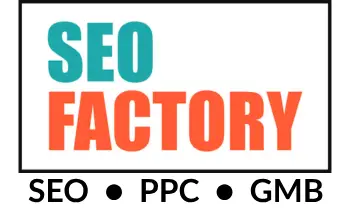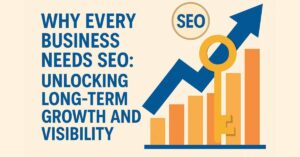In today’s fast-paced digital marketing landscape, businesses constantly grapple with selecting the most effective digital marketing strategy to boost online visibility and drive conversions. Specifically, Search Engine Optimization (SEO) and Pay-Per-Click (PPC) advertising remain two powerhouse approaches for achieving top search engine rankings and capturing targeted audiences. As we navigate 2025, understanding the differences between SEO and PPC is crucial for maximizing return on investment (ROI) and optimizing your online presence. Therefore, this article explores their unique strengths, challenges, and strategic applications, helping you craft a winning digital marketing strategy for 2025.
Understanding SEO and PPC
What is SEO?
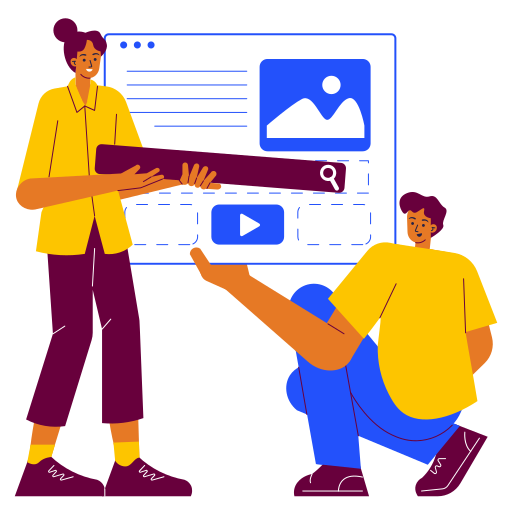
Search Engine Optimization (SEO) involves optimizing a website to achieve higher search engine rankings in organic (non-paid) search results on platforms like Google, Bing, and emerging AI-driven search engines. Essentially, SEO combines on-page, off-page, and technical strategies to enhance visibility for relevant keywords, driving organic traffic to your site. In 2025, SEO has grown more complex than ever, shaped by breakthroughs in artificial intelligence, the growing importance of voice search, and shifting user behaviors.
Key components of SEO include:
- Keyword Optimization: Conducting thorough keyword research to identify high-intent search terms that align with user intent.
- Content Optimization: Creating high-quality, relevant content that satisfies user queries and boosts engagement.
- Technical SEO: Ensuring websites are fast, mobile-friendly, and easily crawlable by search engines to improve search engine rankings.
- Link Building: Acquiring authoritative backlinks to enhance domain credibility and organic traffic.
- User Experience (UX): Prioritizing intuitive navigation, fast load times, and engaging design to support conversion rate optimization.
What is PPC?
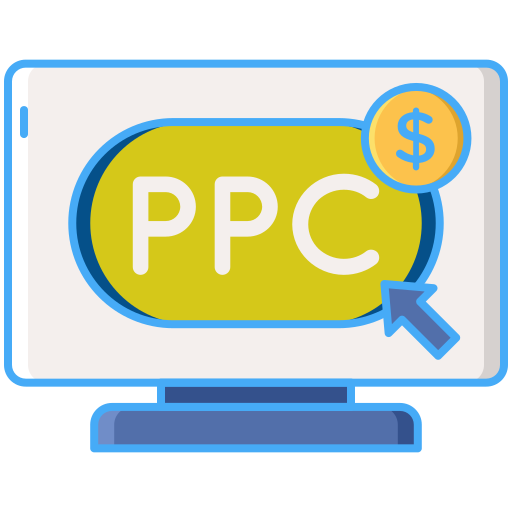
Pay-Per-Click (PPC) advertising, on the other hand, is a paid advertising model where businesses pay a fee each time their ad is clicked. For instance, Google Ads remains the leading platform for paid search campaigns, but PPC also spans social media channels like Meta Ads, LinkedIn Ads, and emerging platforms like X Ads. Consequently, PPC allows businesses to bid on keywords or audience segments to display targeted ads in search results, social feeds, or display networks, driving immediate traffic and conversions.
Key components of PPC include:
- Keyword Bidding: Selecting and bidding on high-value keywords to trigger paid ads.
- Ad Creation: Designing compelling ad copy and visuals to attract clicks and improve click-through rates (CTR).
- Audience Targeting: Using demographic, geographic, and behavioral data to reach specific audiences for precise paid advertising.
- Landing Page Optimization: Creating dedicated landing pages to enhance conversion rate optimization for ad traffic.
- Budget Management: Controlling costs through bid strategies and campaign optimization to maximize ROI.
The Evolution of SEO and PPC in 2025
SEO in 2025: AI and User Intent Drive Organic Success
In 2025, SEO is profoundly influenced by AI-powered algorithms and a strong emphasis on user-focused search experiences. For example, search engines like Google leverage advanced AI models, such as those powering semantic search and natural language processing, to better understand user intent and deliver relevant results. As a result, achieving top search engine rankings requires more than keyword stuffing—it demands high-quality, contextually relevant content optimized for user intent.
- AI-Driven Search: Tools like Google’s Gemini and other AI models prioritize content that answers complex queries conversationally. Specifically, optimizing for long-tail keywords and question-based searches is critical for voice search optimization as AI assistants (e.g., Grok by xAI) gain traction.
- E-E-A-T (Experience, Expertise, Authoritativeness, Trustworthiness): Google’s emphasis on E-E-A-T means businesses must showcase credible authors, transparent sourcing, and user-focused content to boost organic traffic and search engine rankings.
- Zero-Click Searches: With featured snippets, knowledge panels, and AI-generated summaries dominating search results, SEO strategies must focus on capturing visibility in these formats to drive organic traffic.
- Video and Visual SEO: Additionally, the rise of video content on platforms like YouTube and TikTok has made video SEO a key tactic for optimizing metadata and thumbnails to enhance online visibility.
- Local Search Optimization: Hyper-local targeting, driven by mobile searches and “near me” queries, remains crucial for small businesses and service providers aiming to dominate local search rankings.
PPC in 2025: Automation and Precision Fuel Paid Advertising
Meanwhile, PPC advertising has become more sophisticated in 2025, thanks to advancements in AI-driven advertising, machine learning, and cross-platform integration. Consequently, advertisers can leverage AI to optimise paid search campaigns in real-time, although competition and rising costs require strategic precision to maximize ROI.
- AI-Powered Bidding: Smart bidding strategies, such as Google’s Maximise Conversions and Target ROAS, use machine learning to optimise bids based on user behaviour and conversion likelihood, enhancing paid advertising efficiency.
- Audience Segmentation: PPC platforms offer granular targeting options, including lookalike audiences, in-market segments, and AI-driven predictive audiences for precise campaign targeting.
- Ad Format Innovation: Furthermore, interactive ad formats, such as shoppable ads and immersive video ads, are gaining traction, particularly on social media platforms, to boost click-through rates.
- Privacy Challenges: With stricter data privacy regulations and the phasing out of third-party cookies, advertisers must rely on first-party data and contextual targeting for effective paid advertising.
- Cross-Platform Campaigns: Integrating PPC campaigns across search, social, and display networks ensures broader reach and cohesive brand messaging, amplifying online visibility.
Comparing SEO and PPC: Key Factors for Your Digital Marketing Strategy
To decide between SEO and PPC—or how to combine them for an effective digital marketing strategy—businesses must evaluate several factors, including cost, speed, longevity, targeting, and scalability. Below, we provide a detailed comparison to guide your decision-making process.
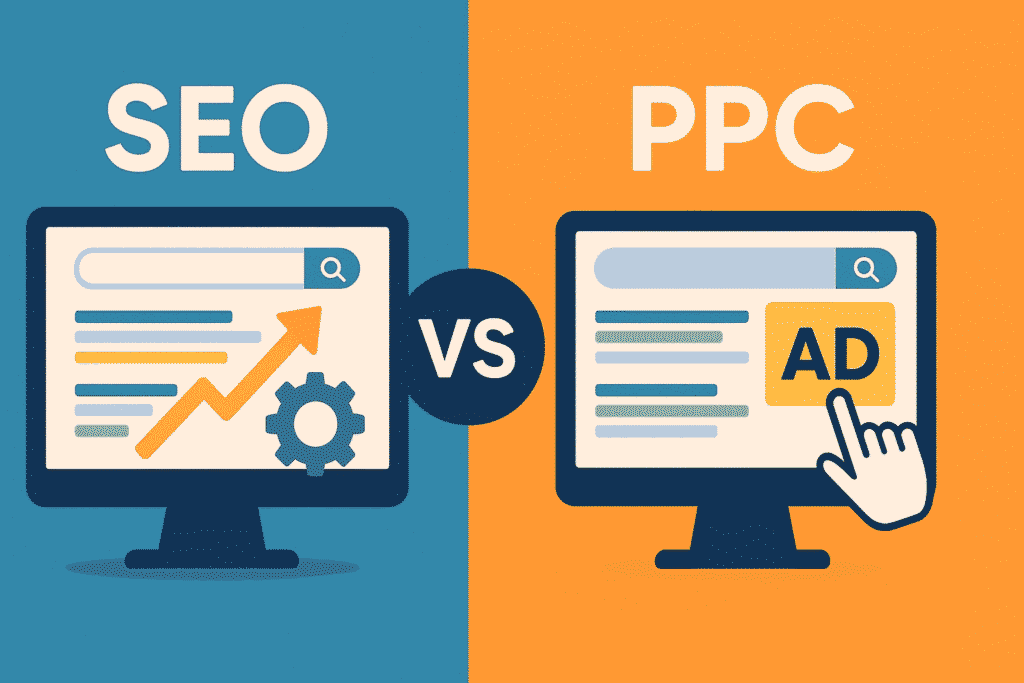
1. Cost and Budget Considerations
SEO:
- Cost Structure: SEO requires an upfront investment in content creation, technical optimization, and ongoing maintenance to drive organic traffic. While there’s no direct cost per click, expenses include hiring SEO experts, content writers, and tools for keyword research and analytics.
- Long-Term Value: Over time, SEO is cost-effective as organic traffic compounds without additional per-click costs, making it a sustainable digital marketing strategy.
- Challenges: However, costs can escalate in highly competitive industries (e.g., finance, legal) where achieving top search engine rankings for high-value keywords demands significant resources.
PPC:
- Cost Structure: In contrast, PPC involves direct costs for every click, with expenses varying based on keyword competition, industry, and targeting. For example, in 2025, competitive keywords like “insurance” or “lawyer” can cost $50–$100 per click in paid search campaigns.
- Budget Control: Advertisers can set daily or campaign budgets, making PPC predictable but potentially expensive for high-traffic paid advertising campaigns.
- Challenges: Additionally, rising ad costs and ad fatigue can reduce ROI if campaigns aren’t optimized regularly for conversion rate optimization.
Verdict: SEO is more cost-effective for long-term organic growth, whereas PPC offers immediate visibility but requires ongoing investment in paid advertising.
2. Speed and Time to Results
SEO:
- Timeline: SEO is a long-term digital marketing strategy, often taking 3–12 months to deliver significant search engine rankings, depending on competition and website authority.
- Factors: For instance, new websites or those in competitive niches may take longer to rank, while consistent content updates and keyword optimization can accelerate progress.
- 2025 Trend: AI-driven content tools can speed up content creation, but search engines still prioritize aged, authoritative domains for organic traffic.
PPC:
- Timeline: Conversely, PPC delivers near-instant results, with paid ads appearing as soon as campaigns are launched and budgets are allocated, driving immediate traffic.
- Factors: Success depends on ad quality, landing page optimization, and bid strategy. Additionally, A/B testing helps optimize results swiftly by identifying which variations drive higher click-through rates.
- 2025 Trend: Automation tools allow for rapid campaign setup and optimization, reducing time to ROI in paid search campaigns.
Verdict: PPC is ideal for immediate results, while SEO is better suited for sustained organic traffic growth.
3. Longevity and Sustainability
SEO:
- Longevity: Once achieved, organic search engine rankings can drive consistent traffic for months or years with proper maintenance, supporting long-term online visibility.
- Sustainability: Furthermore, SEO enhances brand authority and trust, as users typically consider organic search results more credible than paid ads, thereby adding long-term strength to your digital marketing strategy.
- Challenges: However, algorithm updates or competitor strategies can disrupt rankings, requiring ongoing keyword optimization and content updates.
PPC:
- Longevity: In contrast, PPC traffic stops as soon as the budget runs out or the campaign is paused, limiting its long-term impact.
- Sustainability: PPC is less sustainable for businesses with limited budgets but can be highly effective for short-term promotions or launches in paid advertising.
- Challenges: Additionally, ad fatigue and increasing bid costs can diminish long-term effectiveness of paid search campaigns.
Verdict: SEO offers lasting benefits for organic traffic, whereas PPC excels for short-term campaigns or immediate conversions.
4. Targeting and Audience Reach
SEO:
- Targeting: SEO targets users actively searching for specific keywords, making it ideal for capturing high-intent audiences and driving organic traffic.
- Limitations: However, targeting niche demographics or locations without localized content strategies, such as local search optimization, can be challenging.
- 2025 Trend: AI-driven search and semantic understanding allow SEO to target broader, intent-based queries for enhanced search engine rankings.
PPC:
- Targeting: On the other hand, PPC offers precise audience targeting based on demographics, interests, behaviors, and locations, making it ideal for niche paid advertising campaigns.
- Limitations: High-intent keywords can be expensive, and mistargeted campaigns may waste budget, reducing conversion rate optimization.
- 2025 Trend: Cross-platform targeting and AI-driven audience segmentation enhance PPC’s precision in paid search campaigns.
Verdict: PPC excels in granular audience targeting, while SEO captures broader, organic search intent for sustained online visibility.
5. Scalability and Flexibility
SEO:
- Scalability: SEO scales with content production and link-building efforts, but growth is gradual and tied to search engine algorithms, requiring consistent keyword optimization.
- Flexibility: Adjusting SEO strategies (e.g., targeting new keywords) requires time and content updates to maintain search engine rankings.
- 2025 Trend: For example, scalable content strategies, such as programmatic SEO, allow businesses to target thousands of keywords efficiently for organic traffic.
PPC:
- Scalability: Conversely, PPC scales easily by increasing budgets or expanding paid advertising campaigns to new platforms and audiences.
- Flexibility: Campaigns can be adjusted in real-time, allowing quick pivots to new keywords, ad formats, or markets to optimize click-through rates.
- 2025 Trend: AI-driven advertising and cross-channel integration make PPC highly adaptable for dynamic digital marketing strategies.
Verdict: PPC offers faster scalability and flexibility, while SEO requires patience but builds a strong foundation for organic traffic.
Pros and Cons of SEO and PPC
SEO Pros
- Cost-effective over time with compounding organic traffic.
- Builds long-term brand authority and trust, enhancing online visibility.
- Captures high-intent audiences through keyword optimization.
- Aligns with user preference for organic search results.
SEO Cons
- Slow to deliver search engine rankings, especially in competitive niches.
- Requires ongoing investment in content and technical updates for local search optimization.
- Vulnerable to changes in search engine algorithms and competitor strategies, which can impact organic traffic performance.
PPC Pros
- Immediate visibility and traffic through paid search campaigns.
- Highly targeted and customizable campaigns for precise audience reach.
- Measurable outcomes with comprehensive analytics to support conversion rate optimization.
- Ideal for short-term promotions or product launches in paid advertising.
PPC Cons
- Can become costly when targeting highly competitive keywords or operating in saturated industries within paid search campaigns.
- Traffic stops when budgets are exhausted, limiting long-term impact.
- There’s a risk of ad fatigue or declining click-through rates, which can diminish overall campaign effectiveness.
SEO vs PPC: Which is Better for Your 2025 Digital Marketing Strategy?
Ultimately, the choice between SEO and PPC depends on your business goals, budget, and timeline for your digital marketing strategy. Here are some scenarios to guide your decision:
- Startups and New Businesses: PPC is ideal for generating quick online visibility and testing market demand through paid advertising, while SEO lays the groundwork for long-term organic traffic growth.
- E-commerce: For instance, PPC drives immediate sales through product ads, while SEO builds organic traffic for category pages and blogs to improve search engine rankings.
- Local Businesses: Local search optimization is critical for “near me” searches, but PPC can target specific regions with geo-targeted paid ads.
- High-Competition Industries: PPC offers a faster path to online visibility, whereas SEO requires significant investment to compete for top search engine rankings.
- Limited Budgets: SEO is more sustainable for organic traffic, but low-budget PPC campaigns can be effective with careful conversion rate optimization.
The Power of Combining SEO and PPC
In 2025, the most successful digital marketing strategies often integrate SEO and PPC for complementary benefits. Specifically:
- Data Synergy: PPC campaigns provide keyword and audience insights that can inform SEO keyword optimization strategies.
- Brand Visibility: Combining organic and paid results increases brand exposure on search engine results pages (SERPs), enhancing online visibility.
- Retargeting: PPC retargeting campaigns can re-engage users who discovered the brand through organic search, boosting conversion rates.
- Testing and Optimization: Moreover, PPC allows rapid testing of messaging and landing pages, which can then be applied to SEO content for improved search engine rankings.
For example, a business launching a new product might use PPC to drive initial traffic through paid advertising while simultaneously building SEO content to capture organic traffic over time. As a result, this integrated strategy optimizes both short-term and sustained ROI.
Trends Shaping SEO and PPC in 2025
Several trends are shaping the future of SEO and PPC in 2025, influencing your digital marketing strategy. Specifically:
- AI and Automation: AI-driven advertising tools like Grok and Google’s AI models are reshaping both SEO and PPC by enhancing content creation, keyword optimization, and bid optimization.
- Voice and Visual Search: Optimizing for voice queries (e.g., “best coffee shop near me”) and visual search (e.g., Google Lens) is critical for local search optimization, while PPC adapts with image-based paid ads.
- Privacy and Data Regulations: Stricter privacy laws push both strategies toward first-party data and contextual targeting for effective paid advertising and SEO.
- Social Media Integration: PPC campaigns increasingly leverage social platforms like X, while SEO incorporates social signals for authority and improved search engine rankings.
- Sustainability and Ethics: Additionally, consumers in 2025 value brands that prioritize ethical advertising and transparent SEO practices, enhancing brand trust.
Conclusion
In conclusion, SEO and PPC remain indispensable tools for digital success in 2025, each offering distinct advantages for your digital marketing strategy. SEO, the marathon runner, builds sustainable, long-term growth through organic traffic and brand authority via keyword optimization and local search optimization. Conversely, PPC, the sprinter, delivers immediate results and precise targeting through paid advertising for quick wins. Rather than choosing one over the other, businesses can achieve optimal results by leveraging both strategies in tandem, aligning them with specific goals, budgets, and timelines.
As the digital landscape continues to evolve with AI-driven advertising, privacy regulations, and shifting user behaviours, staying agile and informed is essential. Whether you’re a small business aiming for local search dominance or a global brand seeking maximum online visibility, understanding the strengths and limitations of SEO and PPC will empower you to craft a winning digital marketing strategy in 2025.
